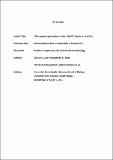Therapeutic applications of the 'NPGP' family of viral 2As
Date
11/2018Metadata
Show full item recordAbstract
Oligopeptide “2A” and “2A‐like” sequences (“2As”; 18‐25aa) are found in a range of RNA virus genomes controlling protein biogenesis through “recoding” of the host‐cell translational apparatus. Insertion of multiple 2As within a single open reading frame (ORF) produces multiple proteins; hence, 2As have been used in a very wide range of biotechnological and biomedical applications. During translation, these 2A peptide sequences mediate a eukaryote‐specific, self‐“cleaving” event, termed “ribosome skipping” with very high efficiency. A particular advantage of using 2As is the ability to simultaneously translate a number of proteins at an equal level in all eukaryotic systems although, naturally, final steady‐state levels depend upon other factors—notably protein stability. By contrast, the use of internal ribosome entry site elements for co‐expression results in an unbalanced expression due to the relative inefficiency of internal initiation. For example, a 1:1 ratio is of particular importance for the biosynthesis of the heavy‐chain and light‐chain components of antibodies: highly valuable as therapeutic proteins. Furthermore, each component of these “artificial polyprotein” systems can be independently targeted to different sub‐cellular sites. The potential of this system was vividly demonstrated by concatenating multiple gene sequences, linked via 2A sequences, into a single, long, ORF—a polycistronic construct. Here, ORFs comprising the biosynthetic pathways for violacein (five gene sequences) and β‐carotene (four gene sequences) were concatenated into a single cistron such that all components were co‐expressed in the yeast Pichia pastoris. In this review, we provide useful information on 2As to serve as a guide for future utilities of this co‐expression technology in basic research, biotechnology, and clinical applications.
Citation
Luke , G A & Ryan , M D 2018 , ' Therapeutic applications of the 'NPGP' family of viral 2As ' , Reviews in Medical Virology , vol. 28 , no. 6 , e2001 . https://doi.org/10.1002/rmv.2001
Publication
Reviews in Medical Virology
Status
Peer reviewed
ISSN
1052-9276Type
Journal item
Description
The authors gratefully acknowledge the long‐term support of the Wellcome Trust and the UK Biotechnology and Biological Sciences Research Council (BBSRC).Collections
Items in the St Andrews Research Repository are protected by copyright, with all rights reserved, unless otherwise indicated.

